Nursing Project: Importance of Change4life Healthy Eating Program and Person Centred Care Approach for Child Development
VerifiedAdded on 2023/06/15
|9
|2737
|435
AI Summary
This nursing project discusses the case of Rosie, a 25-month old girl facing problems in physical growth and development. It highlights the importance of public healthcare program, Change4life healthy eating, and person centred care approach in promoting healthy eating behaviour and child development. It also covers communication strategies, ethical and legal frameworks, and barriers to effective communication.
Contribute Materials
Your contribution can guide someone’s learning journey. Share your
documents today.
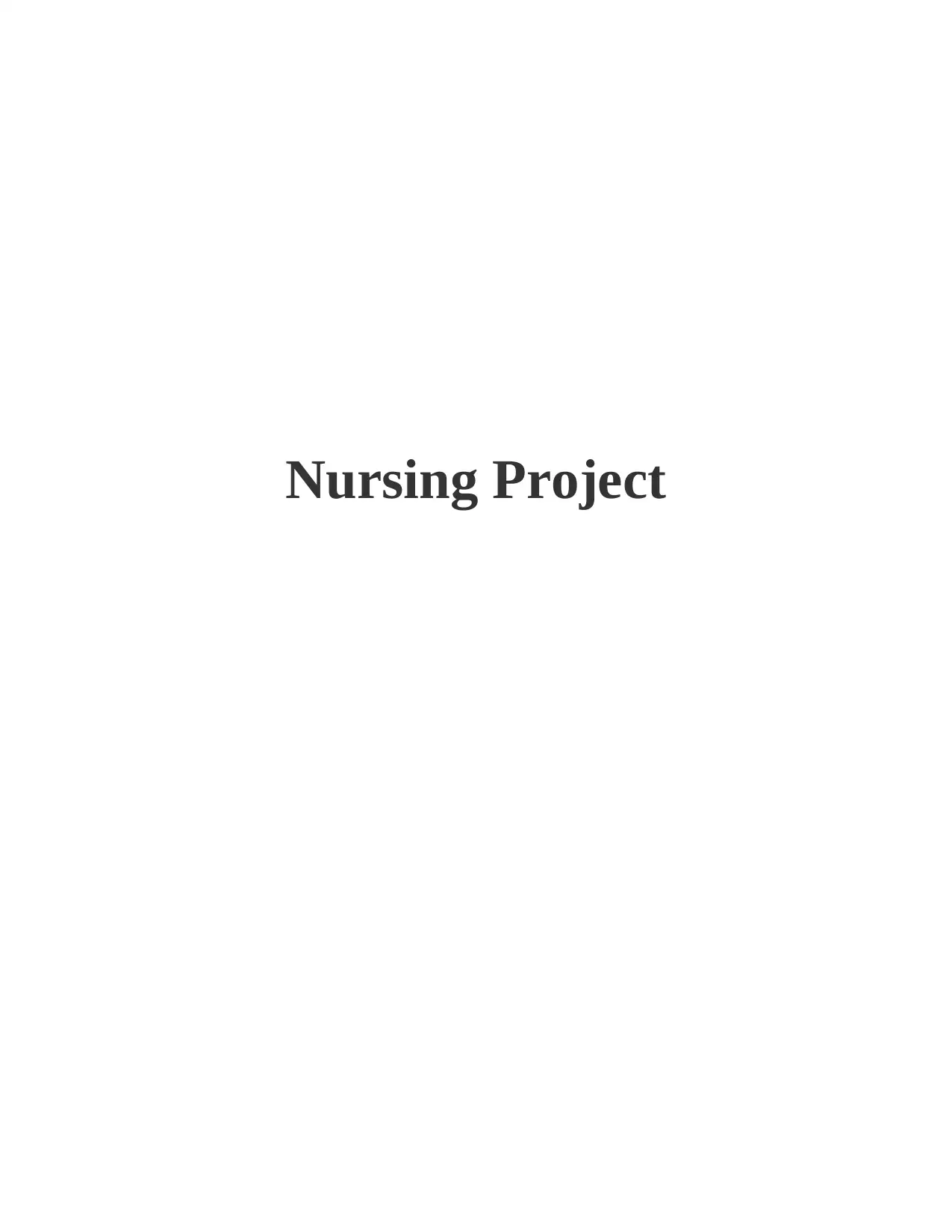
Nursing Project
Secure Best Marks with AI Grader
Need help grading? Try our AI Grader for instant feedback on your assignments.
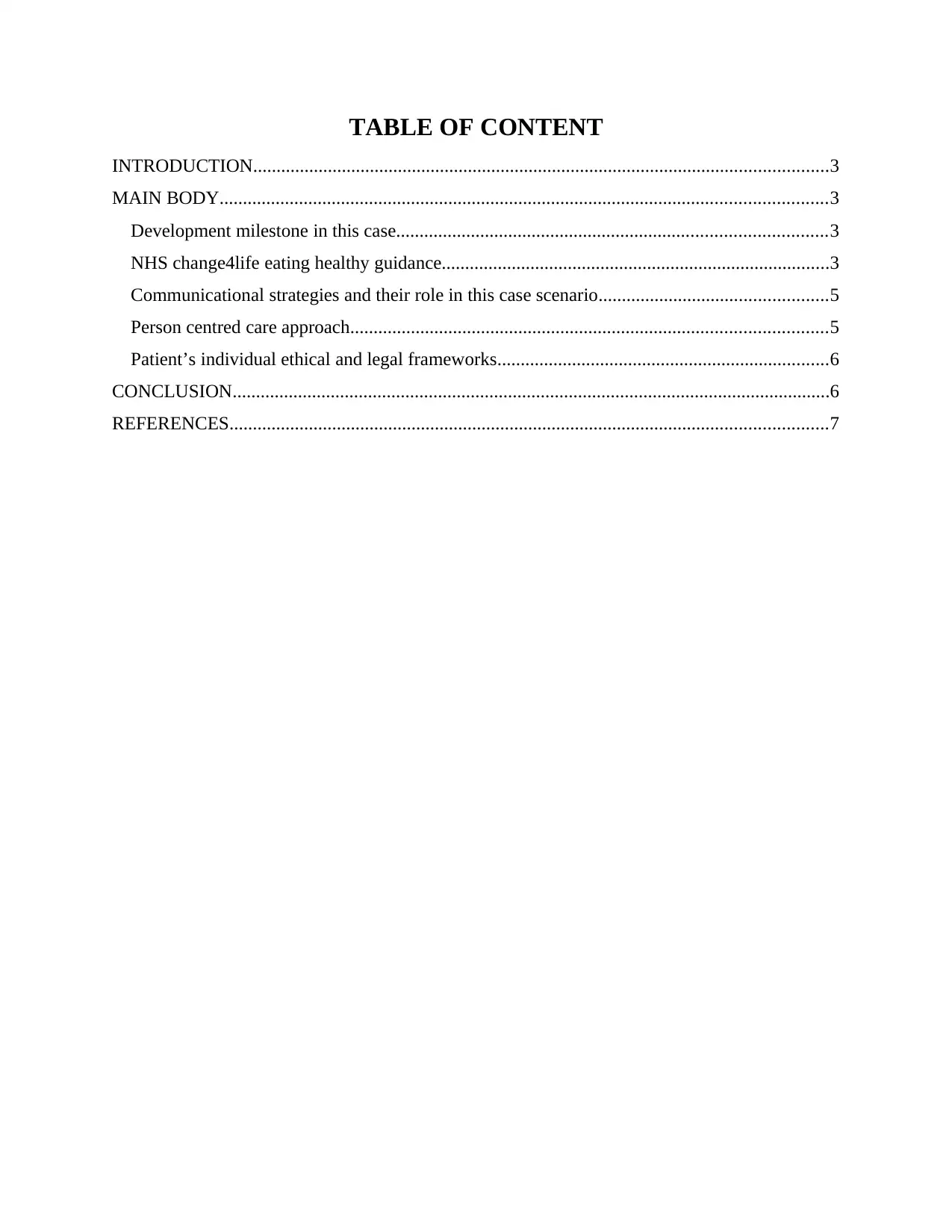
TABLE OF CONTENT
INTRODUCTION...........................................................................................................................3
MAIN BODY..................................................................................................................................3
Development milestone in this case............................................................................................3
NHS change4life eating healthy guidance...................................................................................3
Communicational strategies and their role in this case scenario.................................................5
Person centred care approach......................................................................................................5
Patient’s individual ethical and legal frameworks.......................................................................6
CONCLUSION................................................................................................................................6
REFERENCES................................................................................................................................7
INTRODUCTION...........................................................................................................................3
MAIN BODY..................................................................................................................................3
Development milestone in this case............................................................................................3
NHS change4life eating healthy guidance...................................................................................3
Communicational strategies and their role in this case scenario.................................................5
Person centred care approach......................................................................................................5
Patient’s individual ethical and legal frameworks.......................................................................6
CONCLUSION................................................................................................................................6
REFERENCES................................................................................................................................7
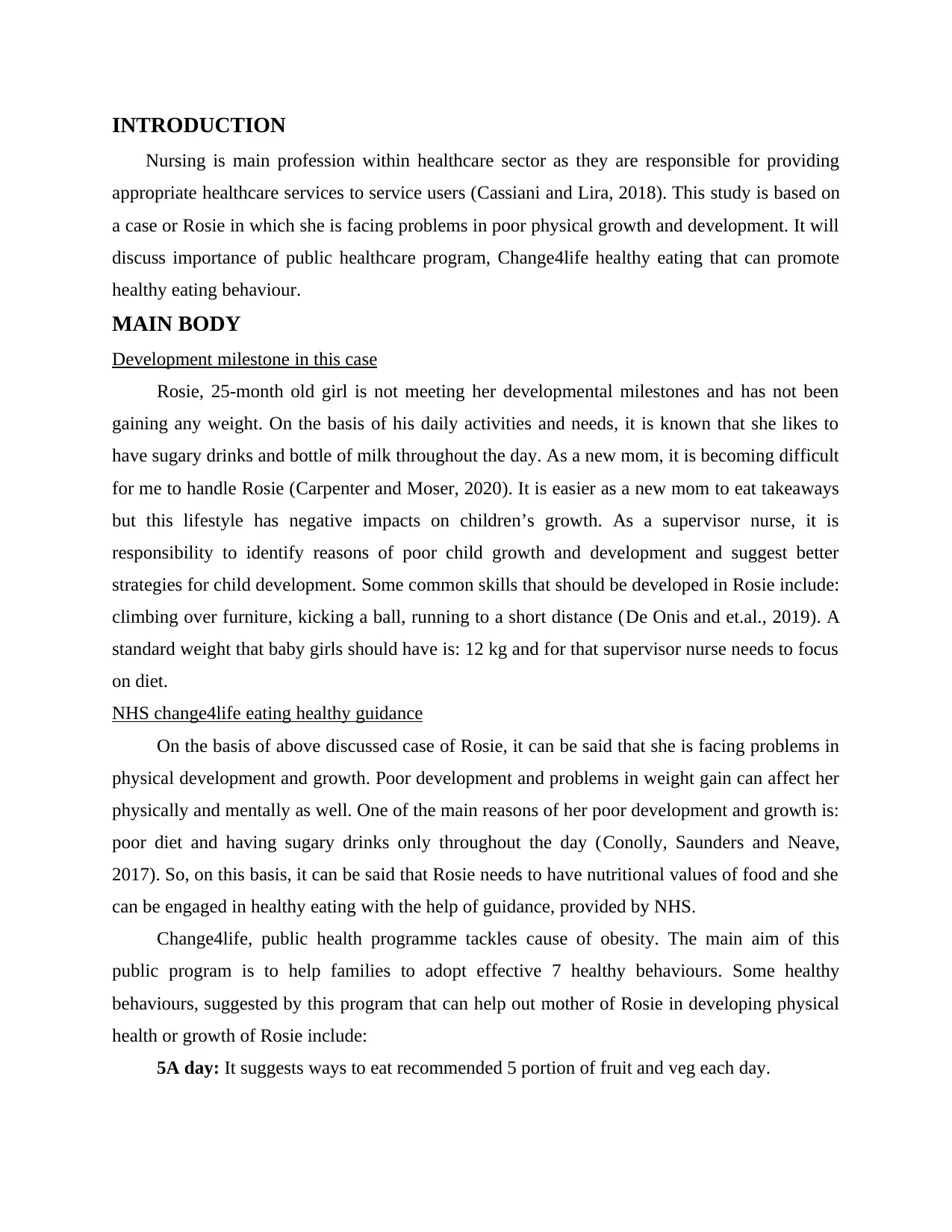
INTRODUCTION
Nursing is main profession within healthcare sector as they are responsible for providing
appropriate healthcare services to service users (Cassiani and Lira, 2018). This study is based on
a case or Rosie in which she is facing problems in poor physical growth and development. It will
discuss importance of public healthcare program, Change4life healthy eating that can promote
healthy eating behaviour.
MAIN BODY
Development milestone in this case
Rosie, 25-month old girl is not meeting her developmental milestones and has not been
gaining any weight. On the basis of his daily activities and needs, it is known that she likes to
have sugary drinks and bottle of milk throughout the day. As a new mom, it is becoming difficult
for me to handle Rosie (Carpenter and Moser, 2020). It is easier as a new mom to eat takeaways
but this lifestyle has negative impacts on children’s growth. As a supervisor nurse, it is
responsibility to identify reasons of poor child growth and development and suggest better
strategies for child development. Some common skills that should be developed in Rosie include:
climbing over furniture, kicking a ball, running to a short distance (De Onis and et.al., 2019). A
standard weight that baby girls should have is: 12 kg and for that supervisor nurse needs to focus
on diet.
NHS change4life eating healthy guidance
On the basis of above discussed case of Rosie, it can be said that she is facing problems in
physical development and growth. Poor development and problems in weight gain can affect her
physically and mentally as well. One of the main reasons of her poor development and growth is:
poor diet and having sugary drinks only throughout the day (Conolly, Saunders and Neave,
2017). So, on this basis, it can be said that Rosie needs to have nutritional values of food and she
can be engaged in healthy eating with the help of guidance, provided by NHS.
Change4life, public health programme tackles cause of obesity. The main aim of this
public program is to help families to adopt effective 7 healthy behaviours. Some healthy
behaviours, suggested by this program that can help out mother of Rosie in developing physical
health or growth of Rosie include:
5A day: It suggests ways to eat recommended 5 portion of fruit and veg each day.
Nursing is main profession within healthcare sector as they are responsible for providing
appropriate healthcare services to service users (Cassiani and Lira, 2018). This study is based on
a case or Rosie in which she is facing problems in poor physical growth and development. It will
discuss importance of public healthcare program, Change4life healthy eating that can promote
healthy eating behaviour.
MAIN BODY
Development milestone in this case
Rosie, 25-month old girl is not meeting her developmental milestones and has not been
gaining any weight. On the basis of his daily activities and needs, it is known that she likes to
have sugary drinks and bottle of milk throughout the day. As a new mom, it is becoming difficult
for me to handle Rosie (Carpenter and Moser, 2020). It is easier as a new mom to eat takeaways
but this lifestyle has negative impacts on children’s growth. As a supervisor nurse, it is
responsibility to identify reasons of poor child growth and development and suggest better
strategies for child development. Some common skills that should be developed in Rosie include:
climbing over furniture, kicking a ball, running to a short distance (De Onis and et.al., 2019). A
standard weight that baby girls should have is: 12 kg and for that supervisor nurse needs to focus
on diet.
NHS change4life eating healthy guidance
On the basis of above discussed case of Rosie, it can be said that she is facing problems in
physical development and growth. Poor development and problems in weight gain can affect her
physically and mentally as well. One of the main reasons of her poor development and growth is:
poor diet and having sugary drinks only throughout the day (Conolly, Saunders and Neave,
2017). So, on this basis, it can be said that Rosie needs to have nutritional values of food and she
can be engaged in healthy eating with the help of guidance, provided by NHS.
Change4life, public health programme tackles cause of obesity. The main aim of this
public program is to help families to adopt effective 7 healthy behaviours. Some healthy
behaviours, suggested by this program that can help out mother of Rosie in developing physical
health or growth of Rosie include:
5A day: It suggests ways to eat recommended 5 portion of fruit and veg each day.
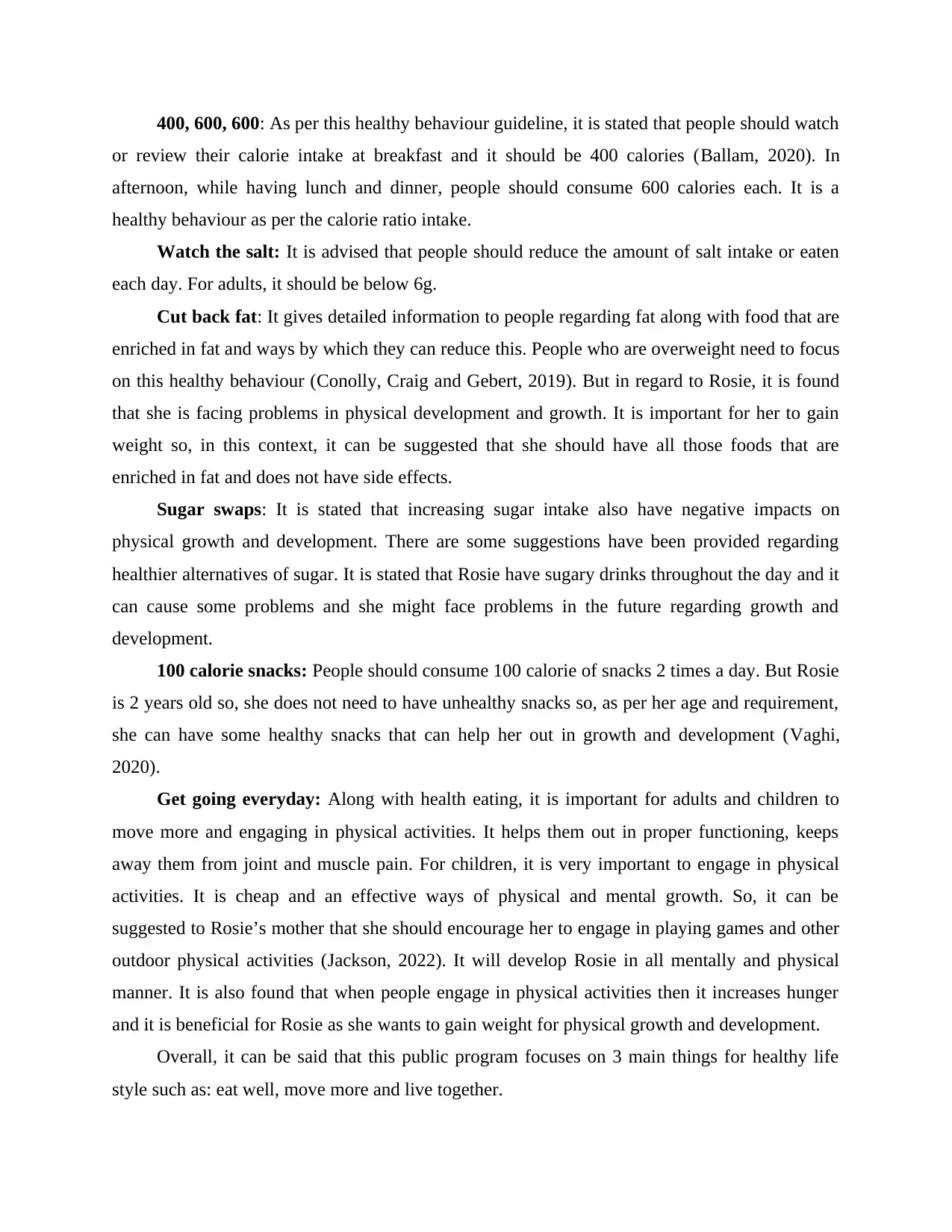
400, 600, 600: As per this healthy behaviour guideline, it is stated that people should watch
or review their calorie intake at breakfast and it should be 400 calories (Ballam, 2020). In
afternoon, while having lunch and dinner, people should consume 600 calories each. It is a
healthy behaviour as per the calorie ratio intake.
Watch the salt: It is advised that people should reduce the amount of salt intake or eaten
each day. For adults, it should be below 6g.
Cut back fat: It gives detailed information to people regarding fat along with food that are
enriched in fat and ways by which they can reduce this. People who are overweight need to focus
on this healthy behaviour (Conolly, Craig and Gebert, 2019). But in regard to Rosie, it is found
that she is facing problems in physical development and growth. It is important for her to gain
weight so, in this context, it can be suggested that she should have all those foods that are
enriched in fat and does not have side effects.
Sugar swaps: It is stated that increasing sugar intake also have negative impacts on
physical growth and development. There are some suggestions have been provided regarding
healthier alternatives of sugar. It is stated that Rosie have sugary drinks throughout the day and it
can cause some problems and she might face problems in the future regarding growth and
development.
100 calorie snacks: People should consume 100 calorie of snacks 2 times a day. But Rosie
is 2 years old so, she does not need to have unhealthy snacks so, as per her age and requirement,
she can have some healthy snacks that can help her out in growth and development (Vaghi,
2020).
Get going everyday: Along with health eating, it is important for adults and children to
move more and engaging in physical activities. It helps them out in proper functioning, keeps
away them from joint and muscle pain. For children, it is very important to engage in physical
activities. It is cheap and an effective ways of physical and mental growth. So, it can be
suggested to Rosie’s mother that she should encourage her to engage in playing games and other
outdoor physical activities (Jackson, 2022). It will develop Rosie in all mentally and physical
manner. It is also found that when people engage in physical activities then it increases hunger
and it is beneficial for Rosie as she wants to gain weight for physical growth and development.
Overall, it can be said that this public program focuses on 3 main things for healthy life
style such as: eat well, move more and live together.
or review their calorie intake at breakfast and it should be 400 calories (Ballam, 2020). In
afternoon, while having lunch and dinner, people should consume 600 calories each. It is a
healthy behaviour as per the calorie ratio intake.
Watch the salt: It is advised that people should reduce the amount of salt intake or eaten
each day. For adults, it should be below 6g.
Cut back fat: It gives detailed information to people regarding fat along with food that are
enriched in fat and ways by which they can reduce this. People who are overweight need to focus
on this healthy behaviour (Conolly, Craig and Gebert, 2019). But in regard to Rosie, it is found
that she is facing problems in physical development and growth. It is important for her to gain
weight so, in this context, it can be suggested that she should have all those foods that are
enriched in fat and does not have side effects.
Sugar swaps: It is stated that increasing sugar intake also have negative impacts on
physical growth and development. There are some suggestions have been provided regarding
healthier alternatives of sugar. It is stated that Rosie have sugary drinks throughout the day and it
can cause some problems and she might face problems in the future regarding growth and
development.
100 calorie snacks: People should consume 100 calorie of snacks 2 times a day. But Rosie
is 2 years old so, she does not need to have unhealthy snacks so, as per her age and requirement,
she can have some healthy snacks that can help her out in growth and development (Vaghi,
2020).
Get going everyday: Along with health eating, it is important for adults and children to
move more and engaging in physical activities. It helps them out in proper functioning, keeps
away them from joint and muscle pain. For children, it is very important to engage in physical
activities. It is cheap and an effective ways of physical and mental growth. So, it can be
suggested to Rosie’s mother that she should encourage her to engage in playing games and other
outdoor physical activities (Jackson, 2022). It will develop Rosie in all mentally and physical
manner. It is also found that when people engage in physical activities then it increases hunger
and it is beneficial for Rosie as she wants to gain weight for physical growth and development.
Overall, it can be said that this public program focuses on 3 main things for healthy life
style such as: eat well, move more and live together.
Secure Best Marks with AI Grader
Need help grading? Try our AI Grader for instant feedback on your assignments.
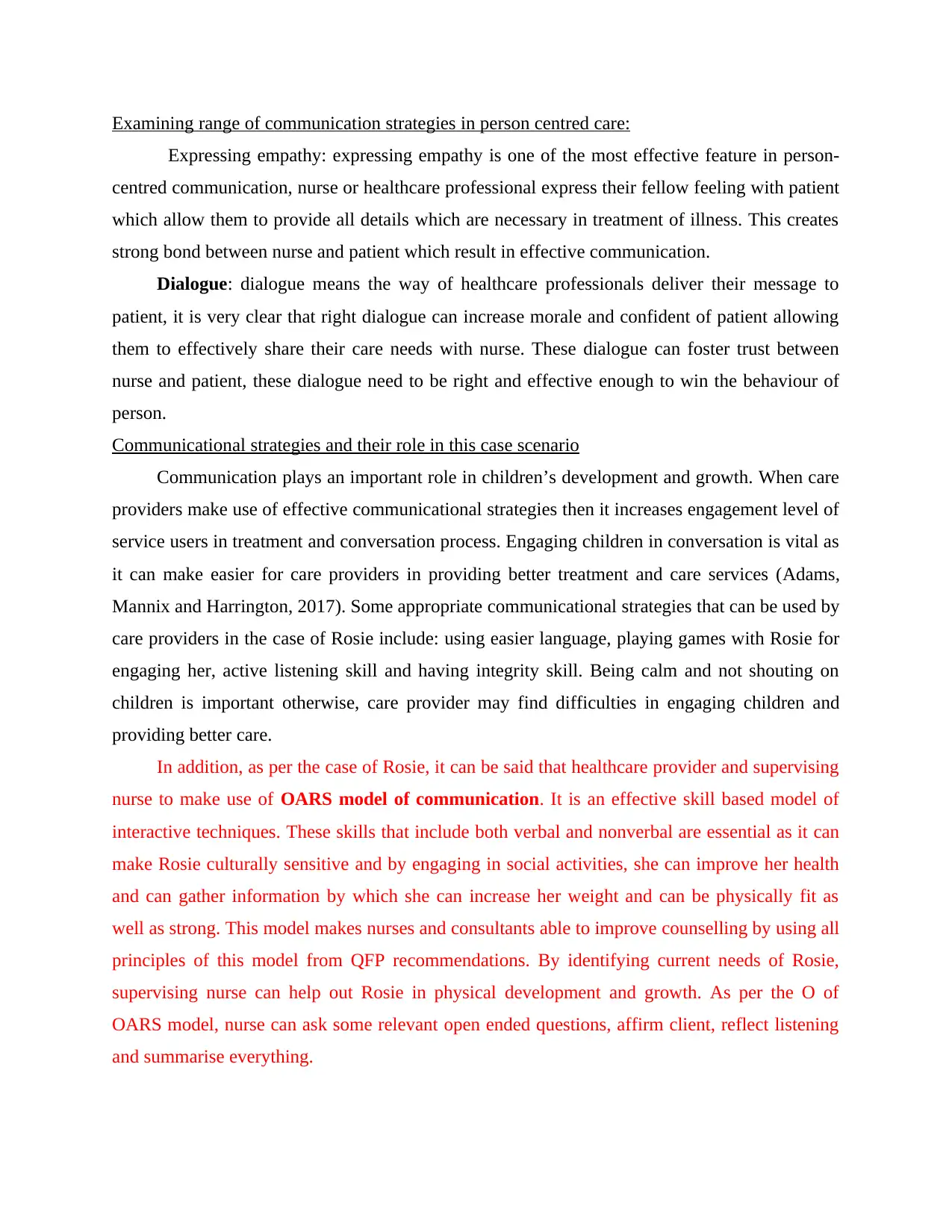
Examining range of communication strategies in person centred care:
Expressing empathy: expressing empathy is one of the most effective feature in person-
centred communication, nurse or healthcare professional express their fellow feeling with patient
which allow them to provide all details which are necessary in treatment of illness. This creates
strong bond between nurse and patient which result in effective communication.
Dialogue: dialogue means the way of healthcare professionals deliver their message to
patient, it is very clear that right dialogue can increase morale and confident of patient allowing
them to effectively share their care needs with nurse. These dialogue can foster trust between
nurse and patient, these dialogue need to be right and effective enough to win the behaviour of
person.
Communicational strategies and their role in this case scenario
Communication plays an important role in children’s development and growth. When care
providers make use of effective communicational strategies then it increases engagement level of
service users in treatment and conversation process. Engaging children in conversation is vital as
it can make easier for care providers in providing better treatment and care services (Adams,
Mannix and Harrington, 2017). Some appropriate communicational strategies that can be used by
care providers in the case of Rosie include: using easier language, playing games with Rosie for
engaging her, active listening skill and having integrity skill. Being calm and not shouting on
children is important otherwise, care provider may find difficulties in engaging children and
providing better care.
In addition, as per the case of Rosie, it can be said that healthcare provider and supervising
nurse to make use of OARS model of communication. It is an effective skill based model of
interactive techniques. These skills that include both verbal and nonverbal are essential as it can
make Rosie culturally sensitive and by engaging in social activities, she can improve her health
and can gather information by which she can increase her weight and can be physically fit as
well as strong. This model makes nurses and consultants able to improve counselling by using all
principles of this model from QFP recommendations. By identifying current needs of Rosie,
supervising nurse can help out Rosie in physical development and growth. As per the O of
OARS model, nurse can ask some relevant open ended questions, affirm client, reflect listening
and summarise everything.
Expressing empathy: expressing empathy is one of the most effective feature in person-
centred communication, nurse or healthcare professional express their fellow feeling with patient
which allow them to provide all details which are necessary in treatment of illness. This creates
strong bond between nurse and patient which result in effective communication.
Dialogue: dialogue means the way of healthcare professionals deliver their message to
patient, it is very clear that right dialogue can increase morale and confident of patient allowing
them to effectively share their care needs with nurse. These dialogue can foster trust between
nurse and patient, these dialogue need to be right and effective enough to win the behaviour of
person.
Communicational strategies and their role in this case scenario
Communication plays an important role in children’s development and growth. When care
providers make use of effective communicational strategies then it increases engagement level of
service users in treatment and conversation process. Engaging children in conversation is vital as
it can make easier for care providers in providing better treatment and care services (Adams,
Mannix and Harrington, 2017). Some appropriate communicational strategies that can be used by
care providers in the case of Rosie include: using easier language, playing games with Rosie for
engaging her, active listening skill and having integrity skill. Being calm and not shouting on
children is important otherwise, care provider may find difficulties in engaging children and
providing better care.
In addition, as per the case of Rosie, it can be said that healthcare provider and supervising
nurse to make use of OARS model of communication. It is an effective skill based model of
interactive techniques. These skills that include both verbal and nonverbal are essential as it can
make Rosie culturally sensitive and by engaging in social activities, she can improve her health
and can gather information by which she can increase her weight and can be physically fit as
well as strong. This model makes nurses and consultants able to improve counselling by using all
principles of this model from QFP recommendations. By identifying current needs of Rosie,
supervising nurse can help out Rosie in physical development and growth. As per the O of
OARS model, nurse can ask some relevant open ended questions, affirm client, reflect listening
and summarise everything.
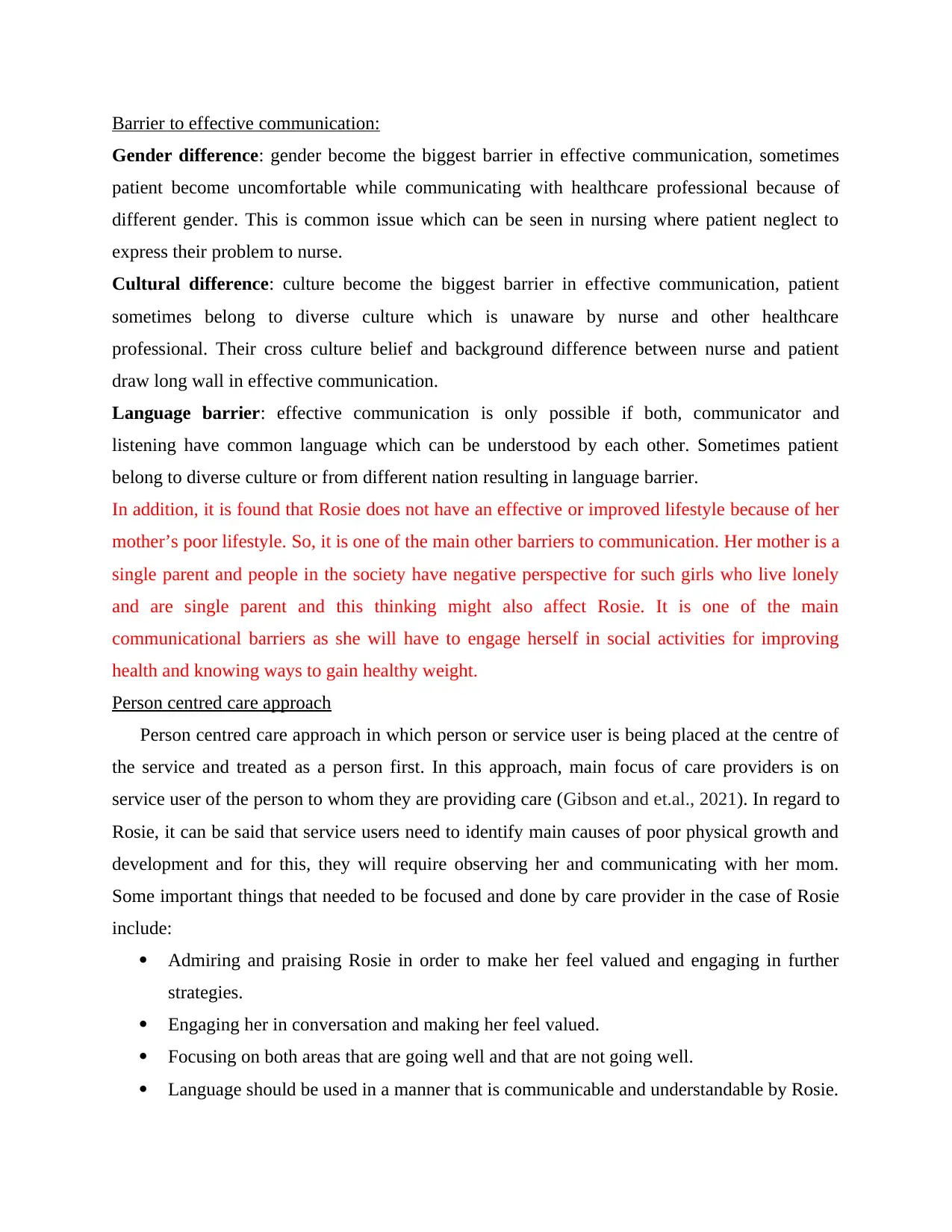
Barrier to effective communication:
Gender difference: gender become the biggest barrier in effective communication, sometimes
patient become uncomfortable while communicating with healthcare professional because of
different gender. This is common issue which can be seen in nursing where patient neglect to
express their problem to nurse.
Cultural difference: culture become the biggest barrier in effective communication, patient
sometimes belong to diverse culture which is unaware by nurse and other healthcare
professional. Their cross culture belief and background difference between nurse and patient
draw long wall in effective communication.
Language barrier: effective communication is only possible if both, communicator and
listening have common language which can be understood by each other. Sometimes patient
belong to diverse culture or from different nation resulting in language barrier.
In addition, it is found that Rosie does not have an effective or improved lifestyle because of her
mother’s poor lifestyle. So, it is one of the main other barriers to communication. Her mother is a
single parent and people in the society have negative perspective for such girls who live lonely
and are single parent and this thinking might also affect Rosie. It is one of the main
communicational barriers as she will have to engage herself in social activities for improving
health and knowing ways to gain healthy weight.
Person centred care approach
Person centred care approach in which person or service user is being placed at the centre of
the service and treated as a person first. In this approach, main focus of care providers is on
service user of the person to whom they are providing care (Gibson and et.al., 2021). In regard to
Rosie, it can be said that service users need to identify main causes of poor physical growth and
development and for this, they will require observing her and communicating with her mom.
Some important things that needed to be focused and done by care provider in the case of Rosie
include:
Admiring and praising Rosie in order to make her feel valued and engaging in further
strategies.
Engaging her in conversation and making her feel valued.
Focusing on both areas that are going well and that are not going well.
Language should be used in a manner that is communicable and understandable by Rosie.
Gender difference: gender become the biggest barrier in effective communication, sometimes
patient become uncomfortable while communicating with healthcare professional because of
different gender. This is common issue which can be seen in nursing where patient neglect to
express their problem to nurse.
Cultural difference: culture become the biggest barrier in effective communication, patient
sometimes belong to diverse culture which is unaware by nurse and other healthcare
professional. Their cross culture belief and background difference between nurse and patient
draw long wall in effective communication.
Language barrier: effective communication is only possible if both, communicator and
listening have common language which can be understood by each other. Sometimes patient
belong to diverse culture or from different nation resulting in language barrier.
In addition, it is found that Rosie does not have an effective or improved lifestyle because of her
mother’s poor lifestyle. So, it is one of the main other barriers to communication. Her mother is a
single parent and people in the society have negative perspective for such girls who live lonely
and are single parent and this thinking might also affect Rosie. It is one of the main
communicational barriers as she will have to engage herself in social activities for improving
health and knowing ways to gain healthy weight.
Person centred care approach
Person centred care approach in which person or service user is being placed at the centre of
the service and treated as a person first. In this approach, main focus of care providers is on
service user of the person to whom they are providing care (Gibson and et.al., 2021). In regard to
Rosie, it can be said that service users need to identify main causes of poor physical growth and
development and for this, they will require observing her and communicating with her mom.
Some important things that needed to be focused and done by care provider in the case of Rosie
include:
Admiring and praising Rosie in order to make her feel valued and engaging in further
strategies.
Engaging her in conversation and making her feel valued.
Focusing on both areas that are going well and that are not going well.
Language should be used in a manner that is communicable and understandable by Rosie.
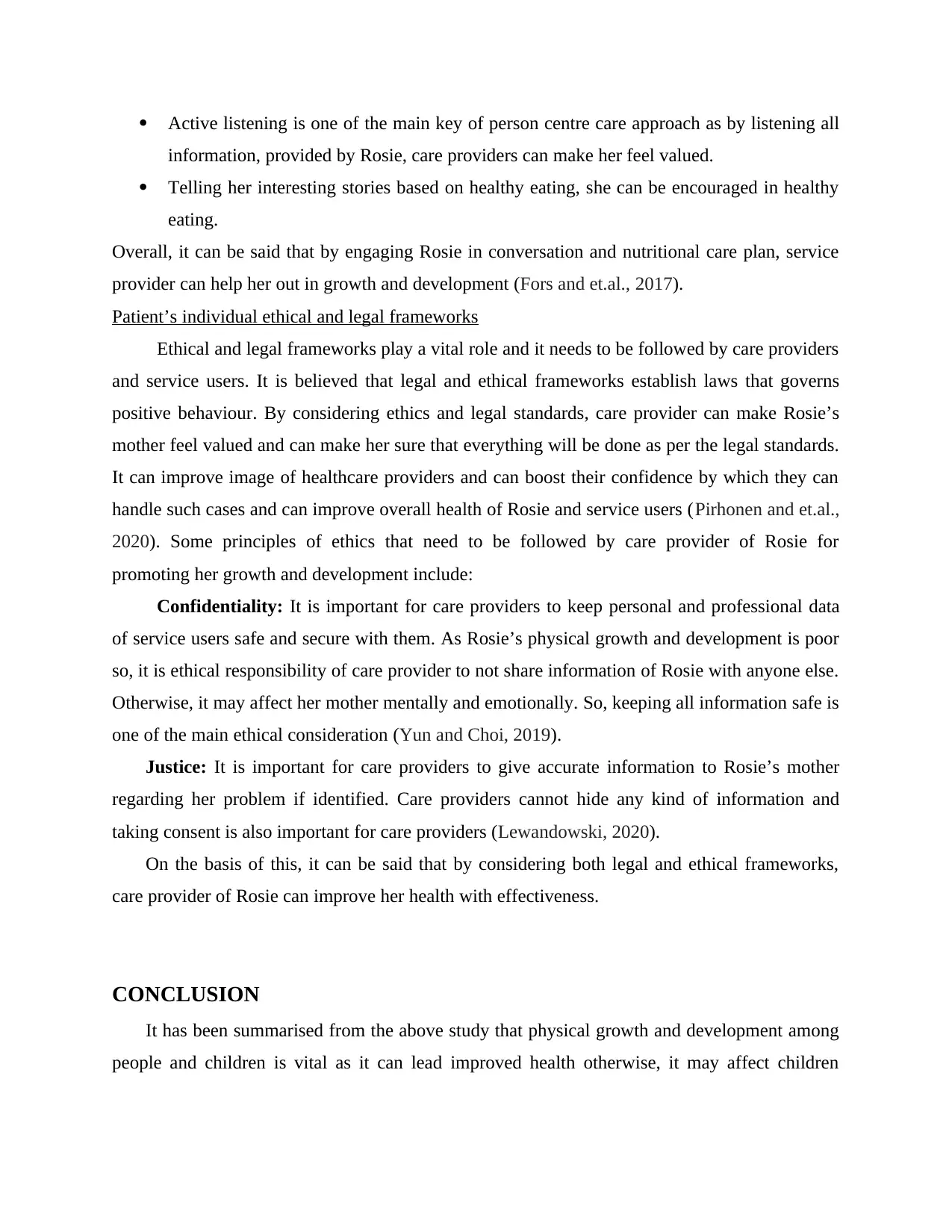
Active listening is one of the main key of person centre care approach as by listening all
information, provided by Rosie, care providers can make her feel valued.
Telling her interesting stories based on healthy eating, she can be encouraged in healthy
eating.
Overall, it can be said that by engaging Rosie in conversation and nutritional care plan, service
provider can help her out in growth and development (Fors and et.al., 2017).
Patient’s individual ethical and legal frameworks
Ethical and legal frameworks play a vital role and it needs to be followed by care providers
and service users. It is believed that legal and ethical frameworks establish laws that governs
positive behaviour. By considering ethics and legal standards, care provider can make Rosie’s
mother feel valued and can make her sure that everything will be done as per the legal standards.
It can improve image of healthcare providers and can boost their confidence by which they can
handle such cases and can improve overall health of Rosie and service users (Pirhonen and et.al.,
2020). Some principles of ethics that need to be followed by care provider of Rosie for
promoting her growth and development include:
Confidentiality: It is important for care providers to keep personal and professional data
of service users safe and secure with them. As Rosie’s physical growth and development is poor
so, it is ethical responsibility of care provider to not share information of Rosie with anyone else.
Otherwise, it may affect her mother mentally and emotionally. So, keeping all information safe is
one of the main ethical consideration (Yun and Choi, 2019).
Justice: It is important for care providers to give accurate information to Rosie’s mother
regarding her problem if identified. Care providers cannot hide any kind of information and
taking consent is also important for care providers (Lewandowski, 2020).
On the basis of this, it can be said that by considering both legal and ethical frameworks,
care provider of Rosie can improve her health with effectiveness.
CONCLUSION
It has been summarised from the above study that physical growth and development among
people and children is vital as it can lead improved health otherwise, it may affect children
information, provided by Rosie, care providers can make her feel valued.
Telling her interesting stories based on healthy eating, she can be encouraged in healthy
eating.
Overall, it can be said that by engaging Rosie in conversation and nutritional care plan, service
provider can help her out in growth and development (Fors and et.al., 2017).
Patient’s individual ethical and legal frameworks
Ethical and legal frameworks play a vital role and it needs to be followed by care providers
and service users. It is believed that legal and ethical frameworks establish laws that governs
positive behaviour. By considering ethics and legal standards, care provider can make Rosie’s
mother feel valued and can make her sure that everything will be done as per the legal standards.
It can improve image of healthcare providers and can boost their confidence by which they can
handle such cases and can improve overall health of Rosie and service users (Pirhonen and et.al.,
2020). Some principles of ethics that need to be followed by care provider of Rosie for
promoting her growth and development include:
Confidentiality: It is important for care providers to keep personal and professional data
of service users safe and secure with them. As Rosie’s physical growth and development is poor
so, it is ethical responsibility of care provider to not share information of Rosie with anyone else.
Otherwise, it may affect her mother mentally and emotionally. So, keeping all information safe is
one of the main ethical consideration (Yun and Choi, 2019).
Justice: It is important for care providers to give accurate information to Rosie’s mother
regarding her problem if identified. Care providers cannot hide any kind of information and
taking consent is also important for care providers (Lewandowski, 2020).
On the basis of this, it can be said that by considering both legal and ethical frameworks,
care provider of Rosie can improve her health with effectiveness.
CONCLUSION
It has been summarised from the above study that physical growth and development among
people and children is vital as it can lead improved health otherwise, it may affect children
Paraphrase This Document
Need a fresh take? Get an instant paraphrase of this document with our AI Paraphraser
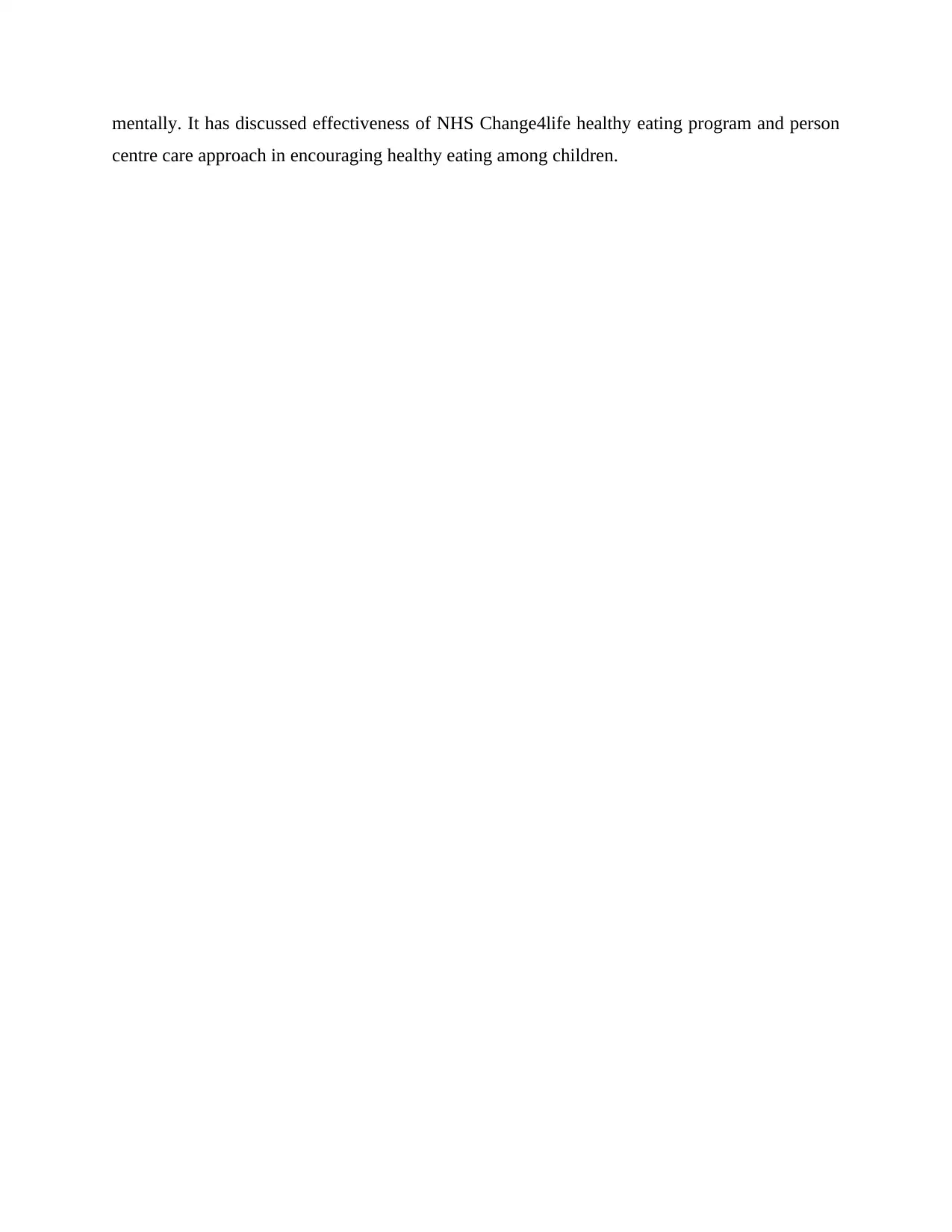
mentally. It has discussed effectiveness of NHS Change4life healthy eating program and person
centre care approach in encouraging healthy eating among children.
centre care approach in encouraging healthy eating among children.
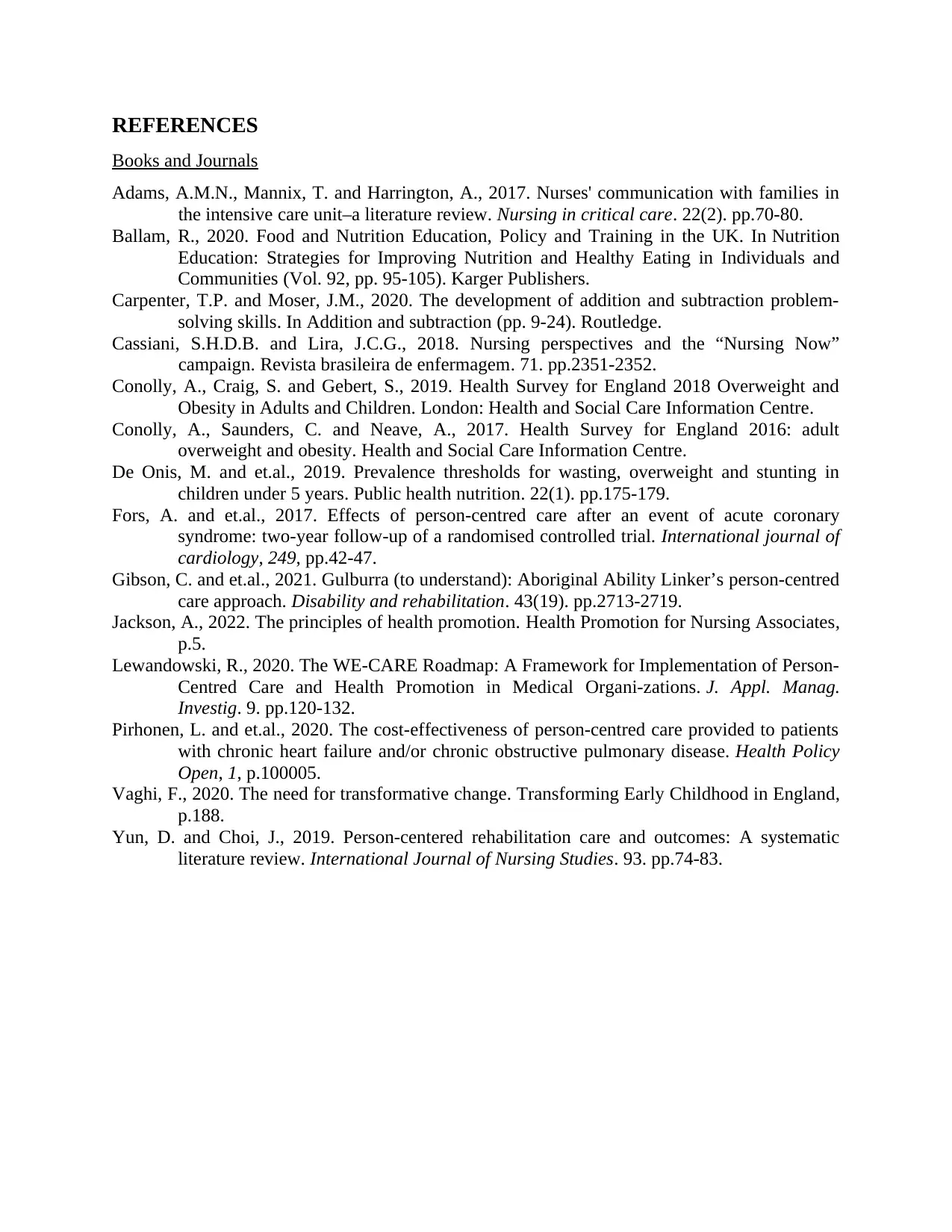
REFERENCES
Books and Journals
Adams, A.M.N., Mannix, T. and Harrington, A., 2017. Nurses' communication with families in
the intensive care unit–a literature review. Nursing in critical care. 22(2). pp.70-80.
Ballam, R., 2020. Food and Nutrition Education, Policy and Training in the UK. In Nutrition
Education: Strategies for Improving Nutrition and Healthy Eating in Individuals and
Communities (Vol. 92, pp. 95-105). Karger Publishers.
Carpenter, T.P. and Moser, J.M., 2020. The development of addition and subtraction problem-
solving skills. In Addition and subtraction (pp. 9-24). Routledge.
Cassiani, S.H.D.B. and Lira, J.C.G., 2018. Nursing perspectives and the “Nursing Now”
campaign. Revista brasileira de enfermagem. 71. pp.2351-2352.
Conolly, A., Craig, S. and Gebert, S., 2019. Health Survey for England 2018 Overweight and
Obesity in Adults and Children. London: Health and Social Care Information Centre.
Conolly, A., Saunders, C. and Neave, A., 2017. Health Survey for England 2016: adult
overweight and obesity. Health and Social Care Information Centre.
De Onis, M. and et.al., 2019. Prevalence thresholds for wasting, overweight and stunting in
children under 5 years. Public health nutrition. 22(1). pp.175-179.
Fors, A. and et.al., 2017. Effects of person-centred care after an event of acute coronary
syndrome: two-year follow-up of a randomised controlled trial. International journal of
cardiology, 249, pp.42-47.
Gibson, C. and et.al., 2021. Gulburra (to understand): Aboriginal Ability Linker’s person-centred
care approach. Disability and rehabilitation. 43(19). pp.2713-2719.
Jackson, A., 2022. The principles of health promotion. Health Promotion for Nursing Associates,
p.5.
Lewandowski, R., 2020. The WE-CARE Roadmap: A Framework for Implementation of Person-
Centred Care and Health Promotion in Medical Organi-zations. J. Appl. Manag.
Investig. 9. pp.120-132.
Pirhonen, L. and et.al., 2020. The cost-effectiveness of person-centred care provided to patients
with chronic heart failure and/or chronic obstructive pulmonary disease. Health Policy
Open, 1, p.100005.
Vaghi, F., 2020. The need for transformative change. Transforming Early Childhood in England,
p.188.
Yun, D. and Choi, J., 2019. Person-centered rehabilitation care and outcomes: A systematic
literature review. International Journal of Nursing Studies. 93. pp.74-83.
Books and Journals
Adams, A.M.N., Mannix, T. and Harrington, A., 2017. Nurses' communication with families in
the intensive care unit–a literature review. Nursing in critical care. 22(2). pp.70-80.
Ballam, R., 2020. Food and Nutrition Education, Policy and Training in the UK. In Nutrition
Education: Strategies for Improving Nutrition and Healthy Eating in Individuals and
Communities (Vol. 92, pp. 95-105). Karger Publishers.
Carpenter, T.P. and Moser, J.M., 2020. The development of addition and subtraction problem-
solving skills. In Addition and subtraction (pp. 9-24). Routledge.
Cassiani, S.H.D.B. and Lira, J.C.G., 2018. Nursing perspectives and the “Nursing Now”
campaign. Revista brasileira de enfermagem. 71. pp.2351-2352.
Conolly, A., Craig, S. and Gebert, S., 2019. Health Survey for England 2018 Overweight and
Obesity in Adults and Children. London: Health and Social Care Information Centre.
Conolly, A., Saunders, C. and Neave, A., 2017. Health Survey for England 2016: adult
overweight and obesity. Health and Social Care Information Centre.
De Onis, M. and et.al., 2019. Prevalence thresholds for wasting, overweight and stunting in
children under 5 years. Public health nutrition. 22(1). pp.175-179.
Fors, A. and et.al., 2017. Effects of person-centred care after an event of acute coronary
syndrome: two-year follow-up of a randomised controlled trial. International journal of
cardiology, 249, pp.42-47.
Gibson, C. and et.al., 2021. Gulburra (to understand): Aboriginal Ability Linker’s person-centred
care approach. Disability and rehabilitation. 43(19). pp.2713-2719.
Jackson, A., 2022. The principles of health promotion. Health Promotion for Nursing Associates,
p.5.
Lewandowski, R., 2020. The WE-CARE Roadmap: A Framework for Implementation of Person-
Centred Care and Health Promotion in Medical Organi-zations. J. Appl. Manag.
Investig. 9. pp.120-132.
Pirhonen, L. and et.al., 2020. The cost-effectiveness of person-centred care provided to patients
with chronic heart failure and/or chronic obstructive pulmonary disease. Health Policy
Open, 1, p.100005.
Vaghi, F., 2020. The need for transformative change. Transforming Early Childhood in England,
p.188.
Yun, D. and Choi, J., 2019. Person-centered rehabilitation care and outcomes: A systematic
literature review. International Journal of Nursing Studies. 93. pp.74-83.
1 out of 9
Your All-in-One AI-Powered Toolkit for Academic Success.
+13062052269
info@desklib.com
Available 24*7 on WhatsApp / Email
![[object Object]](/_next/static/media/star-bottom.7253800d.svg)
Unlock your academic potential
© 2024 | Zucol Services PVT LTD | All rights reserved.
